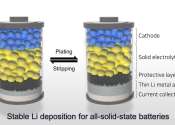Study explores the degradation mechanisms in Cu2O photoelectrodes for CO2 reduction
The efficient and large-scale conversion of carbon dioxide into fuels or other valuable substances could help to address the current energy crisis and mitigate the effects of global warming. One of the most effective approaches ...









